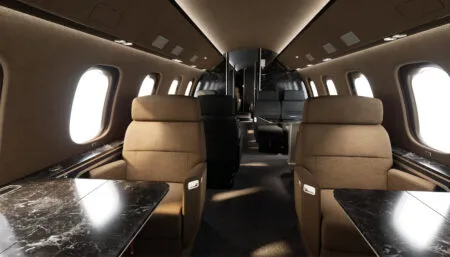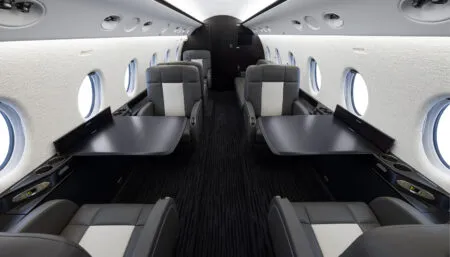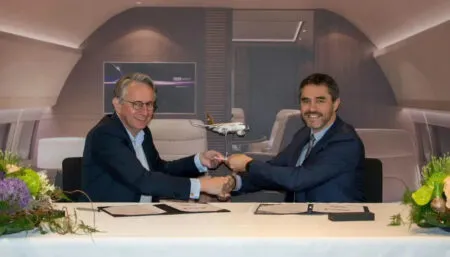Duncan Aviation has unveiled a Falcon 50 refurbished at its full-service MRO facility in Lincoln, Nebraska.
The aircraft arrived in need of paint and maintenance work due to corrosion and other age-related issues that needed to be addressed for safety concerns, the company said. Although the interior was dark and outdated, it was well cared for, the company shared, allowing the existing seats and headliner to be retained.
After purchasing the aircraft, the owners wanted to make it their own and modernise it for their specific needs. The first-time Duncan Aviation customer took advantage of the downtime during the 4C inspection and added paint, avionics and interior upgrades to the workscope.
“This aircraft arrived in Lincoln for a 4C inspection, which is a massive inspection that includes overhaul of the landing gear, restoration of flight controls, completely removing the interior, and inspecting nearly every part of the structure,” said Jennifer Morrill, project manager. “During this large maintenance event the customer elected to have Gogo Avance L5 installed. We also added a large interior workscope to spruce up the aircraft for the new owners, as well as new, custom exterior paint.”
Hydrographic design
The owners elected to replace the carpet and countertops and reupholster the lower sidewalls and divan. When the aircraft input, the Duncan Aviation sales and finish team leaders evaluated the cabinets and formulated a plan that included complete cabinet hydrographic finish.
Senior lead designer Stephanie Kuhn explained that the hydrographic design serves as the focal point of the interior. “Having the ability to print the graphics ourselves allows us to customise the colour of the veneer digitally before printing,” she said. “This capability liberates us from the constraints of traditional veneer species and opens up a world of possibilities in terms of colour customisation.”
Kuhn describes the interior as “modern moody” with a fusion of contemporary design elements that create a space that feels elegant and enigmatic. All of the existing black leather from the original interior was retained, and served as the foundation for the new design. The main objective was to lighten and soften the overall aesthetic to counterbalance the weightiness of the black leather seats.
The leather sidewalls were chosen for durability, and the owners opted for a lighter shade to create contrast with the seats. They also selected an embossing technique to introduce texture and depth to the material. The lighter, modern grey plush carpet has subtle accents of black to complement the leather elements in the space.
Kuhn said the owners proved to be exceptional collaborators throughout the project: “One of the owners is a talented photographer and artist, and demonstrated a remarkable knack for design,” said Kuhn. “This streamlined the material selection process significantly.”
Paint work
During one of the owner’s visits, Kuhn presented multiple paint scheme options, along with paint samples, for consideration. They took an active role in the decision-making process, and made selections for both the scheme layout and paint colours based off the options she provided.
“The frosting on the cake was the custom exterior paint scheme complete with a discrete company logo,” said Morrill. “The before and after pictures tell the story more clearly, but it is hard to recognise this aircraft after a few months at the Duncan Aviation facility.”
Multi-shop project
Morrill said she enjoyed having the owners visit the facility multiple times to see the progress and meet with the teams. “It is always a pleasure to work with customers like this,” said Morrill. “I get an enormous sense of pride to show off the amazing work and coordination that occurs during a large, multi-shop project like this.”
Morrill said one of the most interesting aspects of a large multi-shop project is the scope of team members who end up working on them. “This is something that is truly unique and special about Duncan Aviation,” said Morrill. “We have men and women who spend their careers honing their skills and become masters of a particular task. The massive effort of coordinating who does what and in what timeframe is a layered effort that reaches from our schedulers, hangar coordinators, sales, design, project managers, project manager assistants, team leaders, crew leads, department managers, technicians, quality, MRTs, and others. Not to mention the feat of sourcing, ordering, delivering parts, and managing the cores of the old parts.”
After large projects, Morrill likes to run a report to find out the number of people who had a hand in the project. She found that more than 321 team members contributed and invested in its completion.
“That only captures the efforts put in by people directly working on this project and doesn’t represent the efforts put forth by our supporting teams like the line team, facilities, parts runners who keep the planes moving and the facility safe and clean for these projects to even happen,” said Morrill. “Regardless, this project was a team effort and could not have been possible without the entire team at Duncan Aviation.”




